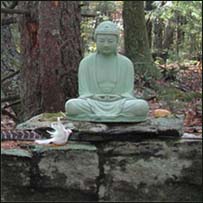|
|
 |
Please support Dharma Seed with a 2025 year-end gift.
Your donations allow us to offer these teachings online to all.

|

|

|
The greatest gift is the
gift of the teachings
|
|

|
| |
|
Dharma Talks
|
2017-06-16
I Teach Pleasure
62:57
|
|
Ajahn Sucitto
|
|
|
The Buddha taught pleasure. When the mind feels safe and comforted, it doesn’t crave. It loses its fear and regret. This is pleasant. Sila helps us practice this skill of turning things to the subtle pleasure of releasing stress and pressure. We stop creating the boundary of self and other that prevents unification. To others as to myself.
|
|
Meditationszentrum Beatenberg
:
The Wisdom of Embodiment
|
|
|
2017-06-15
Benefactors: Part 2, Helping Others Shine.
64:51
|
|
James Baraz
|
|
|
Description:
This is a follow-up to James' "Appreciating Our Benefactors" talk (5-25-17).
Besides gratitude for those who've been our benefactors, we can see ourselves as passing on the kindness and caring we've received. We can and do have a significant effect on everyone around us. We can practice seeing the beautiful qualities in others, believing in them and bringing out the best in them. By doing so we help them shine, make a meaningful contribution to the world and experience great joy.
This talk also includes some words about James' local basketball team the Golden State Warriors, who just became NBA champions. The coach, Steve Kerr, tries to instill four core qualities in his players--joy, mindfulness, compassion and competition. And the players' unselfish style, subjugating individual glory for the good of the team, is the key to their success. They embody the attitude of bringing out the best and enjoying seeing each other shine.
|
|
Insight Meditation Community of Berkeley
:
IMCB Regular Talks
|
|
|
2017-06-14
Meditation: Homecoming to Our Life Breath
15:59
|
|
Tara Brach
|
|
|
Perhaps the most universal place to collect and deepen attention is the breath. This meditation begins with an intentional breath that calms the nervous system, and then opens to a clear, intimate presence with our natural breathing. With breath as our home base, we practice returning again and again when the mind becomes distracted. As presence grows, we can let the breath be in the foreground, and include whatever waves of life come and go. This brings a quiet mind, and a peaceful, happy heart.
|
|
Insight Meditation Community of Washington DC
:
IMCW Wednesday Evening Talks
|
|
|
2017-06-14
Stories That Imprison Our Heart – Part 1
53:00
|
|
Tara Brach
|
|
|
Our suffering arises from fear-based stories that are often outside our awareness. These include stories of our deficiency or importance, of being a victim, of being unseen or unloved, of facing failure or rejection. This is true collectively too. We have shared stories of bad “others” that fuel wars, shared stories of the value of continued growth in consumption and production that destroy our earth, shared stories of our human right to enslave and violate other animals. We have the capacity to bring the stories that separate and imprison us into the light of awareness, and with great compassion, loosen their grip. These two talks look at the ways fear-based stories create suffering, and how awakening from them reveals the freedom of our true, and universal, belonging.
|
|
Insight Meditation Community of Washington DC
:
IMCW Wednesday Evening Talks
|
|
|
2017-06-13
Goodwill – Giving Yourself Back to Yourself
67:57
|
|
Ajahn Sucitto
|
|
|
Goodwill isn’t about changing things, but bringing up the right atmosphere and steeping your awareness in that. The right atmosphere isn’t 100% approval or love or celebration, but a quality of granting permission. Non-resistance, non-aversion. Experiences of exclusion and being treated as an object cause the citta to close down over time, and we lose the ability to feel anything. Subjective presence will give yourself back to yourself.
|
|
Meditationszentrum Beatenberg
:
The Wisdom of Embodiment
|
|
|
2017-06-13
Trust
26:27
|
|
Ajahn Metta
|
|
|
Trust can support us in our practice. Trust in terms of inspiration, aspiration, what brings us here and keeps us here practicing. Trust isn’t something that comes easily for everyone because of our past disappointments. Yet trust grows stronger by going through difficulties disappointments and expectations that are not met by staying with things in the moment. Then things are always alright, always manageable.
|
|
Meditationszentrum Beatenberg
:
The Wisdom of Embodiment
|
|
|
|
|